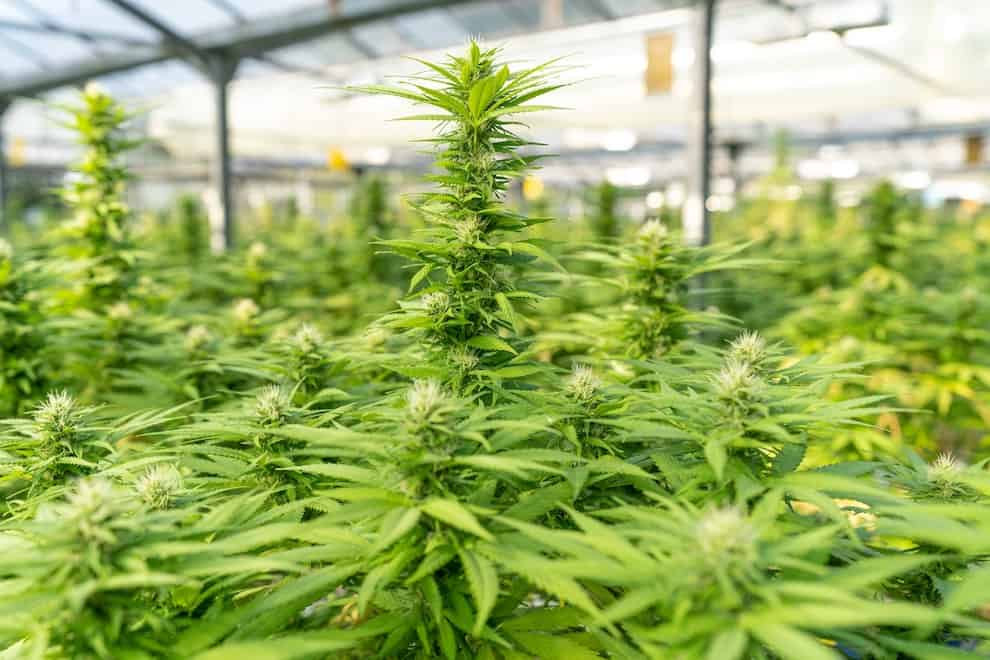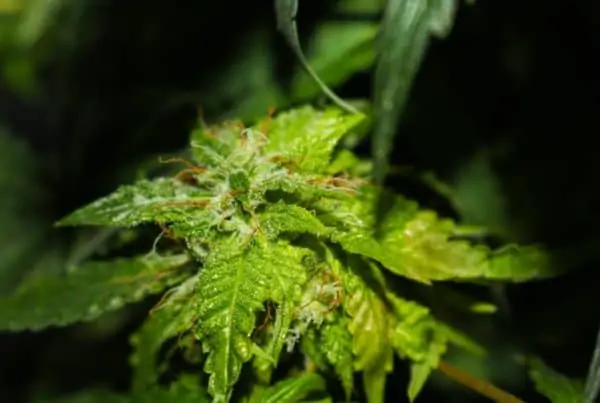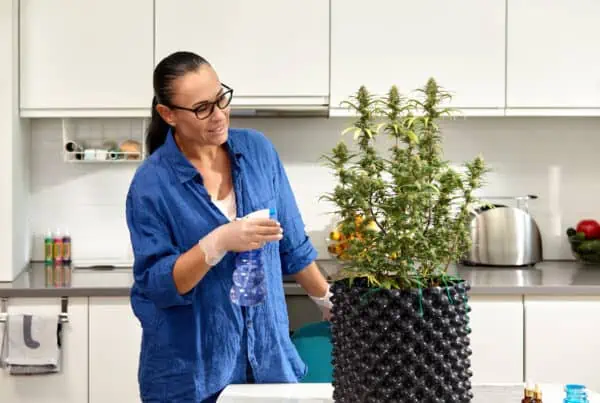TABLE OF CONTENTS
How big do marijuana plants get? How long do they take to fully mature? These are some of the most common questions asked by new growers. Ultimately, the size of your marijuana plants will depend on their genetics and the growing environment.
In our cannabis plant size guide, we touch upon the different factors that can affect the size of your crop.
- Are you growing an indoor or outdoor garden?
- Did you plant a sativa or indica strain?
- When do you plan to switch from the vegetative stage to the flowering stage?
We answer all of these questions in detail to help you understand the growth patterns of the cannabis plant. Knowing this can help you have a successful yield time after time.
Size Matters – How Big Do Marijuana Plants Get?
As a cannabis grower, predicting the height of your plants is an important factor when setting up your garden and choosing the best practices that work for you.
Cannabis plants can grow as small as 1 ½ foot tall and up to 24 feet tall!
The 24 foot tall hemp plant is the largest registered although there may be some even taller!
As you can see, the range of plant sizes is wide. Growers have some degree of control over how tall their cannabis plants can grow. Some growers may prefer smaller plants to fit in cramped spaces, while others may seek larger plants to maximize their outdoor yield.
Carefully planning your garden, from the types of seeds you buy to the cultivation methods you use, can help you grow a marijuana plant that is the perfect size for your growing environment and specific needs.
Indoor vs. Outdoor Gardens
One of the most important factors to consider when estimating the size of your marijuana plants is their growing environment. Do you plan to grow indoors or outdoors?
With indoor cannabis cultivation, you have the ability to control nearly every parameter of its environment including temperature, humidity, and light. In addition, using special cannabis training techniques can help manage a plant’s height while increasing yields.
Common plant training techniques include:
- Low-stress training (LST): LST involves bending and tying down branches and stems to create an even canopy and better light distribution.
- Screen of green (SCROG): Using a screen, cannabis plants can be trained to grow horizontally instead of vertically so that you can create an even canopy. This technique is usually reserved for tall-growing sativa strains.
When growing cannabis outdoors, growers have some control over the height of the plant, but mainly rely on the natural elements (sunlight, temperature, humidity). Generally, plants can grow considerably taller than indoor plants, if they get enough direct sunlight and root space.
For outdoor-grown cannabis, container size and root space are critical. If the root space is too small, plant growth can be stunted.

Sativa vs. Indica vs. Autoflowering Strains
Genetics also plays a critical role in the growth pattern of a cannabis plant. While you can control many environmental factors that can reduce or extend the height of your plant, its height will ultimately depend on its genetic composition.
Generally, indica strains grow short and squat, while sativa strains grow tall and thin under the same growing conditions.
Of course, there are exceptions to the rule. It is important to research your strain to determine its expected height and grow it accordingly.
Autoflowering strains are a variety of cannabis that differ from traditional photoperiod plants that require the light cycle to switch from its vegetative to its flowering stage. Autoflowering strains automatically switch to their flowering stage after a specific amount of time, not a change in the light cycle.
On average, autoflowering strains can grow between 1.5 and 3.5 feet tall, perfect for small spaces.
Vegetative vs. Flowering Stages
Cannabis plants have a unique growth cycle that can be divided into its vegetative and flowering stages. During the vegetative stage, the plant is focused on foliage growth. During its flowering stage, it is focused on bud growth.
Plants that are allowed to spend a longer time in their vegetative stage tend to grow taller than ones that spend a short time in this stage. The length of time that your plant spends in its flowering stage depends on its genetics and growing environment.
In indoor gardens, growing cannabis plants too tall can make them reach too close to your grow lights, which can cause the harsh light to burn your plants and buds.
Many growers choose to switch from their vegetative stage to the flowering stage when the plant has reached about half the size of its desired height. During the flowering stage, plants can nearly double in size, on average.
Of course, there are many considerations that determine when to switch to the flowering stage. Some strains may require the switch earlier or later than recommended to reach the desired height.
How Big Do Cannabis Plants Get FAQ's
Can I Keep Marijuana Plants Small Intentionally?
Yes, you can keep marijuana plants small through using methods like Sea of Green (SOG), or Screen of Green (SCROG), pruning on a regular basis, and choosing strains that are known to not grow very much.
How Fast Do Marijuana Plants Grow?
Under optimal conditions marijuana plants grow pretty fast. In the vegetative stage, they can grow many inches per week. The growth rate will depend on factors like nutrients, lights used, genetics of the strain and environmental conditions.
Does Pot Size Affect the Growth of Marijuana Plants?
Yes, a pot's size has a big impact on how big a marijuana plant gets. Greater root space in larger pots may result in larger plants. On the other hand, cannabis plants grown in smaller pots may have slower root growth and a smaller total height.
What is the Average Size of a Marijuana Plant at Harvest?
At harvest, average size varies. When grown outdoors, Sativa strains can grow up to 12 feet tall, but Indica strains may only reach 3 to 6 feet in height. There will be differences in hybrids. Recall that, particularly in regulated indoor situations, the size also depends on when you move the plants from the vegetative stage to the flowering stage. Keep in mind cannabis plants typically double in size when comparing end of vegetative growth to the end of the flowering phase.
How Tall Can Marijuana Plants Grow?
Cannabis plants can vary significantly in height according on the strain and cultivation circumstances. While Sativa strains can grow as tall as 6 to 12 feet or more, Indica strains usually grow 3 to 6 feet tall. Hybrids will lie in the middle based on their genetic composition.
What Factors Affect the Size of a Marijuana Plant?
A marijuana plant's size is influenced by a number of variables, such as genetics (strain), availability of light, growing media, supply of nutrients, and growing area. Because there is more room and natural light accessible to them, outdoor plants typically grow larger than indoor grown weed.
Can I Control the Height of My Marijuana Plants?
Yes, you may regulate the height of cannabis plants using methods like LST (low-stress training), topping (removing the plant's top), and light exposure control (particularly in indoor setups). These techniques can be useful for controlling cannabis plant size, particularly in small areas.
How Wide Do Marijuana Plants Get?
Cannabis plants vary in width; some Indica strains can grow to be rather bushy and wide, often measuring twice as wide as they are tall. Sativa strains typically develop as taller than wide plants. Training methods such as LST might affect the width.
“
There are over 300,000 jobs in the cannabis industry. CTU trained me for one of them!

Makes $24.50 @ THC +
Does bigger cannabis plants mean bigger buds?
The size of the buds on cannabis plants is not always directly correlated. Because of their greater structure and higher surface area, larger plants frequently have the ability to generate more buds, but this does not guarantee larger individual buds. The size and quality of cannabis buds are influenced by a number of factors, including the type of lighting utilized, genetics, grow room dimensions, growth environment, plant training methods, and pruning.
Maximize Your Yield, Enroll in Cannabis Training University
Growing cannabis indoors or outdoors requires careful consideration of your garden setup. Learn the answer to how big do marijuana plants get and much more at Cannabis Training University’s online cannabis college.
CTU breaks down every part of the cultivation process in simple terms so you can grow a plant that is the perfect size for you.
Learn from the top growers in the world how to set up a garden on a budget and use advanced growing techniques to control the height of your plant. Our curriculum can help you maximize your growing space to get the best yield, potency, aroma, and flavor from your crop.
Ready to optimize your cannabis garden? Enroll in the top cannabis certification courses at Cannabis Training University, the leading online cannabis school!

Luis Cordova
Luis Cordova is a distinguished author, and renowned expert in cannabis cultivation, who possesses a Master's degree in Plant Biotechnology and Pharmaceutical Science. As a valued contributor to highly esteemed publications such as Cannabis Training University and Maximum Yield Magazine, Luis has emerged as a trusted source of guidance and knowledge in the cannabis industry. Having written thousands of informative articles, Luis is widely recognized for his comprehensive expertise on cultivating cannabis, both indoors and outdoors.












 Jeff was involved in an accident where he endured a traumatic brain injury. He had a week-long stay in ICU where brain surgeons
Jeff was involved in an accident where he endured a traumatic brain injury. He had a week-long stay in ICU where brain surgeons  100% risk free money back guarantee within 48 hours after purchase if student has not completed any of the courses or exams.
100% risk free money back guarantee within 48 hours after purchase if student has not completed any of the courses or exams.